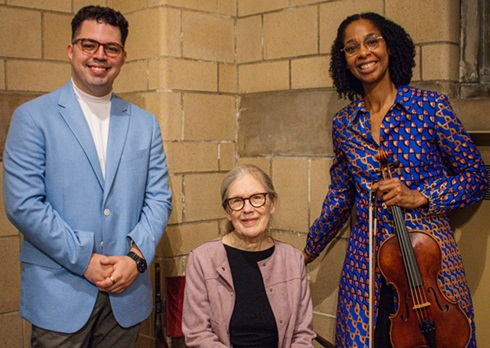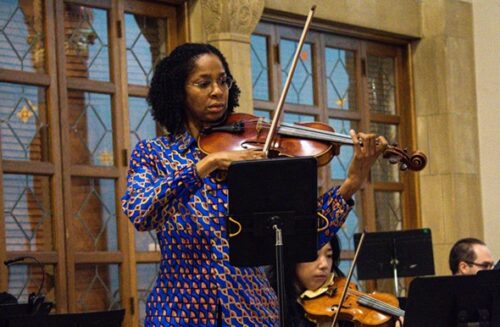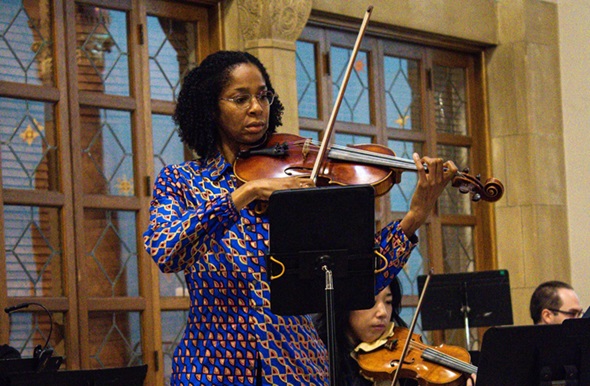 United States Bach, Brouwer, Brahms: Eliesha Nelson (viola), CityMusic Cleveland Chamber Orchestra / Lorenzo Lopez (conductor). Our Lady of Angels Church, Cleveland, 27.10.2024. (MSJ)
United States Bach, Brouwer, Brahms: Eliesha Nelson (viola), CityMusic Cleveland Chamber Orchestra / Lorenzo Lopez (conductor). Our Lady of Angels Church, Cleveland, 27.10.2024. (MSJ)

Bach – Brandenburg Concerto No.6 in B-flat major
Margaret Brouwer – Viola Concerto
Brahms – Serenade No.2 in A major, Op.16
With a recent Naxos release of works performed by the Vienna Radio Symphony under Marin Alsop, American composer Margaret Brouwer’s reputation keeps expanding. Her striking but accessible music is always worth hearing, and this occasion brought a chamber orchestra rescaling of Brouwer’s 2011 Viola Concerto, originally written for Ellen Rose and the Dallas Symphony Orchestra. The composer adapted it for the CityMusic Cleveland Chamber Orchestra and had the orchestra’s impressive Eliesha Nelson as soloist.
The work enacts a journey from fury to serenity and onward to joy, powered by fragments of the chant Ubi caritas, which doesn’t make a full appearance until near the end of the first movement, after the soloist’s clipped and aggressive gestures have been diffused by interactions with the orchestra. When the chant does arrive, it is in a breathtaking passage with the ecstatic solo viola accompanied by harmonics on the lower string instruments and a haunting flute.
This gives the piece an interesting trajectory. Where most concertos have either an antagonistic relationship between the solo part and the full tutti passages or a cooperative first-among-equals approach, Brouwer’s work makes a powerful expressive point by starting as one and developing into the other. One thing that remains prominent in the chamber version of the piece is the use of mallet percussion instruments and bells. The reverberant acoustics of Our Lady of Angels Church worked gloriously for the concerto, the percussion instruments’ tintinnabulations becoming a glowing halo of sound that Nelson’s rich tone contrasted with vividly and dramatically.
The slow movement, taking its title ‘… fair as the moon, bright as the sun…’ from the Biblical Song of Songs, was sung with tender elegance by Nelson’s viola. In contrast, the finale, ‘Blithesome Spirit’, showed how nimble Nelson could make the instrument, capering with infectious energy. A passage with swift glissandos passed from viola to the orchestra and back was both completely modern sounding and delightfully witty. The orchestra stayed with Nelson every step of the way under the attentive direction of Lorenzo Lopez, and the performance brought the audience to its feet. Brouwer, who was present and looked delighted with the rendition, took a bow from her spot in the pews after the soloist and conductor insisted.

In a lovely opening to the concert, six of the orchestra’s players had joined Nelson in front of the chancel, almost in the pews where the audience sat, for an intimate encounter with Bach’s Brandenburg Concerto No.6. A conductor was not used for the small group, though Nelson was clearly in charge, setting tempos and introducing phrasings that were then passed through the other instruments. The performance was animated though poised and elegant, with principal violist Jonathan Bagg taking the second solo part. Bagg exchanged and overlapped phrases fluently with Nelson and led off the songful second movement radiantly. The performance did not in any way suffer from comparison with last week’s stellar outing by the by the local period instrument specialists, Apollo’s Fire (review here), and had the advantage of using modern cellos for the viola da gamba parts, aiding in the audibility of those lines which are often lost in larger performance spaces.
The venue proved somewhat less ideal for Brahms’s Serenade No.2. Whereas the small group for the Bach and the style of orchestration in Brouwer’s concerto benefitted from the church’s bright resonance, some of Brahms’s tightly-woven details were blurred by the acoustics. The fuzzy halo of sound was not a major problem except in the finale, where some of the delicious woodwind details were lost, and it cast the work’s pensive slow movement in an unusually radiant cushion of sound, benefiting its thoughtful meditation.
Conductor Lopez kept the piece light on its feet and flowing, which greatly helped the first movement and Scherzo. Perhaps a slightly broader tempo would have allowed the notes of the Rondo finale to sound out from the depths of the chancel a little more, but the work still landed its charm pleasantly. Less pleasing, if quite humorous, was the performance having to pause and wait for a tuneful assault from the church’s bell tower between the third and fourth movements, thanks to an automated carillon that someone forgot to turn off.
That aside, the church proved an effective venue, one of several that the ensemble will be appearing at during this, its twenty-first season.
Mark Sebastian Jordan
